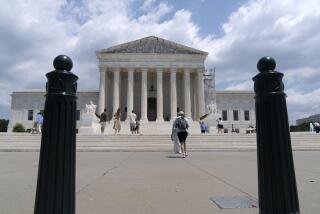Who can sue over religious symbols?
Today’s topic: Who should have standing to sue over displaying religious icons on public land? Can anyone offended claim actual injury, or should standing in these cases be determined by narrower criteria? Erwin Chemerinsky and Joseph Infranco continue their debate on Salazar vs. Buono, a case scheduled to be argued in the Supreme Court on Oct. 7. Click here for a backgrounder from the Pew Research Center.
Point: Joseph Infranco, Alliance Defense Fund senior counsel
With this question, we come to the issue that many court observers think will decide Salazar vs. Buono.
As we both agree, Erwin, standing is a separate issue from the underlying establishment clause questions. Where we disagree is that the issue is settled. Standing to challenge alleged establishment clause violations is a relatively recent judicial creation. The Supreme Court first gave standing to taxpayers in establishment clause challenges in 1968, though that decision did not specifically address “offended observers.” In fact, when the Supreme Court finally addressed something like psychological harm through “observation” in a 1982 decision, it denied standing. Inconsistent or unclear holdings abound on the subject, with the Supreme Court showing a recent willingness to further limit standing.
Erwin, you are correct in noting that many establishment clause cases based on offended observer standing do not raise the issue; many do, however. I could give examples from some successful Alliance Defense Fund litigation. Whether all lawyers think to raise the subject of standing, though, is not the issue. The question is whether a party who has suffered no objective harm but merely dislikes something should be able to sue to eradicate religious references on public monuments. The Supreme Court may well have accepted this case to answer that in the negative, or at least limit its application.
Standing generally requires that individuals have a concrete and particularized injury, and not something hypothetical or speculative -- like offended sensibilities. It is impossible to foresee the many ways concrete harm can occur, but mere feelings should not be enough to attack things like the national motto or Pledge of Allegiance because they acknowledge God as part of our heritage. Nor should it be a basis to attack a veterans’ memorial because the military uses the symbol of a cross. In fact, I suspect the ACLU uses offended observers in such cases because it cannot find plaintiffs who have suffered concrete injuries.
Let us be clear about the underlying philosophical dispute, readily acknowledged by both of us. Your stated preference is a “secular” government. By this expression, you do not mean a “neutral” government that does not prefer one religion to another. Rather, you go further and advocate for a government that may not prefer religion to “non-religion,” even in a general or ceremonial way. In actual application, this often amounts to hostility, not neutrality. Ironically, this argument will be made in the Supreme Court, whose marshal opens sessions by declaring, “God save the United States and this honorable court.”
Strictly speaking, we’re straying off standing here, though it seems necessary to me. If standing is the horse and the establishment clause the cart, we want to see what is attached to the horse before it arrives. We need to understand the extreme view advanced by these types of lawsuits. The agenda behind a “secular” government has produced lawsuits that have sought to ban reciting the Pledge of Allegiance in schools because of the words “under God” (though, of course, no child is required to recite the pledge), get rid of military chaplains, remove “In God We Trust” as a national motto and eliminate people taking an oath before God prior to testifying (again, no one is required to do this). These lawsuits over crosses on military memorials are manifestations of this extreme secular world view.
Let’s have a brief history lesson for the readers. The establishment clause says: “Congress shall make no law respecting an establishment of religion.” Note the absence of words like “separation” or “secular.” The history and context are clear: The founding fathers did not want something like a Church of England -- an established church -- in America. Many people today associate the establishment clause with the so-called separation of church and state, a phrase that does not appear in the Constitution or Declaration of Independence. The latter, in an inconvenient fact for secular groups, freely refers to “God” and “divine providence.” It also acknowledges God as the source of human rights. Remember that business about how “all men are endowed by their creator with certain unalienable rights”?
The words about a “wall of separation” come from a letter Thomas Jefferson wrote to a Baptist church in Danbury, Conn. after his election. The letter was written in response to the church’s concerns over government hostility because Baptists were a disfavored minority. The separation metaphor was intended to reassure the church and had nothing to do with government acknowledgment of religion. In fact, days after writing that letter, Jefferson attended distinctly Christian religious worship services at the Capitol building in Washington. Worse yet for separatists, he ordered the U.S. Marine Corps band to play the worship music. Had you told Jefferson (who was a deist with suspicions about organized religion) that the establishment clause meant a cross honoring veterans could not be placed on public land, he likely would have had a good laugh at your joke.
This nation has a rich tradition of acknowledging our religious heritage in public. The aggressive attempt to replace it with a secular agenda is really a product of the last 60 years, and much of it -- thankfully -- has been rejected. A further rejection of standing on the grounds one is merely “offended” by a veterans’ memorial would be a welcome development.
Counterpoint: Erwin Chemerinsky, UC Irvine School of Law dean
For decades, the Supreme Court has allowed individuals to challenge religious symbols on government property without questioning standing. In countless cases, the court has considered the constitutionality of Nativity scenes, 10 Commandments displays, crosses and menorahs without doubting that alleged violations of the establishment clause impose an injury that is sufficient for standing. Indeed, the limits that the establishment clause impose on government are rendered meaningless if no one has the ability to sue to stop violations.
You say, Joe, that only those who suffer “objective harm” can sue to challenge a religious symbol on government property. You say that individuals who object to religious symbols, such as crosses on government property, have no more of an injury than “offended sensibilities.” Your position seems to be that no one has standing to challenge a religious symbol on government property.
I would challenge you to answer two questions. First, do you think that any religious symbol on government property would violate the establishment clause? And if so, who would have standing to challenge such a display? My sense is that you see no problem with any religious display on government property and that you would accord no one standing to challenge religious displays.
If my understanding of your position is correct, then the discussion of whether the monument is a tribute to slain soldiers is irrelevant. You would allow the cross whether or not this was its purpose.
You attempt to dismiss those who seek to limit religious displays on government property by calling them “mean spirited” and saying they have “eggshell-thin sensibilities” and an extreme secular view. Such rhetoric misses the point.
The establishment clause, according to decades of Supreme Court interpretation, prohibits the government from endorsing religion or a particular religion. A religious symbol that does this is a violation of a constitutional right. The Supreme Court has long held that violations of constitutional rights are injuries that meet the requirements for standing. The central idea is that the establishment clause creates a right for individuals to have a government that does not engage in practices that advance religion or a particular faith. The establishment clause is effectively nullified if no one can sue to enforce its limits on government.
You refer to the cases that involve the ability of taxpayers to sue to stop government expenditures that may violate the establishment clause. But the Supreme Court has accorded standing to people who challenge religious displays on government property even when no taxpayer funds were spent. In 2005, the Supreme Court considered whether a 10 Commandments monument on the Texas state capitol grounds violated the establishment clause. The court did this even though the monument had been privately donated and cost the state nothing. Not one justice questioned the standing of the homeless man who sued.
The limit on religious symbols on government property is not about perpetuating an extreme secularist view of the 1st Amendment. I believe that the establishment clause was created to ensure that government be secular; that, as Justice Sandra Day O’Connor eloquently explained, it is to ensure that the government can be perceived by all as their government. If the government endorses religion or a particular religion, then those of another or no faith may feel like outsiders.
Religious symbols on government property are an endorsement of religion, which is prohibited. The establishment clause is a constitutional limit on government and a constitutional right of individuals, not a matter of protecting sensibilities. Ensuring that the government be secular is not hostility to religion. The place for religion is on private property, private homes and places of worship. A robust free exercise clause protects this. At the very least, the government must be neutral among and toward religion. Such neutrality is not and never has been about hostility to religion.
To enforce that neutrality, someone must have standing to sue to challenge offending religious symbols. Any person who encounters such symbols has standing to sue. Joe, you would gut the establishment clause by finding that no one has standing to sue to enforce it.
More to Read
A cure for the common opinion
Get thought-provoking perspectives with our weekly newsletter.
You may occasionally receive promotional content from the Los Angeles Times.










